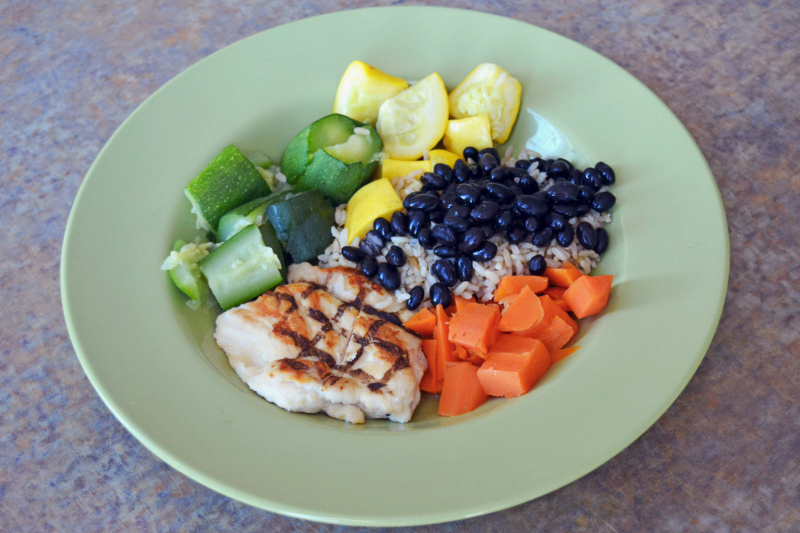
Being heart-healthy involves preventing and managing cardiovascular disease by living a balanced lifestyle that consists of a healthy diet and regular exercise. Creating healthy habits and focusing on positive, long-term patterns is the key, and there are a few broad recommendations from the American Heart Association that can help you create these patterns of wellness and meet your goals.
- Use up at least as many calories as you take in. Consider your nutrient intake for your age, gender, and activity level. Also aim for at least 150 minutes of moderate physical activity, 75 minutes of intense physical activity, or a combination of the two each week.
- Eat an overall healthy dietary pattern that emphasizes a wide range of fruits and vegetables, whole grains, lean sources of protein including protein from legumes and nuts, low-fat or nonfat dairy, vegetable oils, and minimal intake of added sugars, salt, and alcohol.
- Apply this guidance wherever food is prepared or consumed, and create healthy overall patterns.
- Live tobacco free by avoiding smoking, vaping, or the use of other tobacco and nicotine products as well as secondhand smoke or vapor.
What Are Some Heart-Healthy Foods?
Heart-healthy foods span all 5 food groups: fruits, vegetables, grains, protein, and dairy. Some examples include:
- Berries: Berries contain antioxidants, which may decrease the risk of heart disease.
- Leafy greens: Leafy greens are rich in vitamin K, which may lower the risk of heart disease.
- Whole grains: Whole grains such as whole grain bread, whole grain pasta, and popcorn are high in dietary fiber, which may help lower blood cholesterol.
- Salmon: Salmon is high in Omega-3 fatty acids, which may decrease the likelihood of blood clots.
- Beans/Legumes: Beans and legumes are rich in phytochemicals, which may have cardioprotective properties.
- Yogurt: Yogurt contains calcium, which may protect against hypertension.
How Do I Eat Heart-Healthy In The UGA Dining Commons?
UGA Dining Services labels each menu item with helpful symbols to denote if a dish is “Meatless”, “Vegan”, or a “Taste of Home Recipe.” Finding heart-healthy menu items is also a breeze, as they are labeled with a red “Heart Healthy” symbol.
The heart-healthy symbol “![]() ” indicates that 1 serving of the menu item contains:
” indicates that 1 serving of the menu item contains:
- Less than 10% of calories from saturated fat
- Less than 0.5g of trans fat
- Less than 8 grams of added sugar
- Less than 480 mg of sodium
The heart-healthy symbol, along with other nutrition symbols, give students the power to make their own informed decisions in all UGA dining commons. Choosing heart-healthy items encourages long-term health and well-being, and making informed choices without restriction promotes a happy and healthy life.
What Else Can UGA Offer That Encourages Heart Health?
UGA has a number of resources for students looking to improve or maintain their heart health. The UGA Peer Nutrition Educators offers free 1-1 nutrition advisement sessions, the University Health Center provides by-request $5 cooking classes, and UGA Recreational Sports hosts group fitness classes, intramural sports, and wellness coaching. Grab a snack, bring your friends, and try a new activity!
October Upcoming Events:
- Wednesday, October 19 at 5:30pm: Painting & Poses at Lake Herrick Pavillion
- Wednesday, October 19 at 6:00pm: Trail Building Clinic
- Saturday, October 22 at 7:00am: Vertical Caving Overnight Trip
- Saturday, October 22 at 8:00am: Laurel Fork Falls Kayaking Overnight Trip
- Friday, October 28 at 5:00pm: Roan Highlands Overnight Trip
- Wednesday, November 2 at 8:00pm: Try Climb / Night Heights
- Sunday, November 6 at 8:00am: My Helen Adventure (Unicoi)
- Sunday, November 6 at 8:00am: Rock Climbing at Mount Currahee
Visit the following sites for more information on these events and other heart-healthy opportunities!
- https://dining.uga.edu/nutrition/pne/
- https://healthpromotion.uga.edu/nutrition/kitchen/
- https://uga.campuslabs.com/engage/events
Source: www.heart.org

